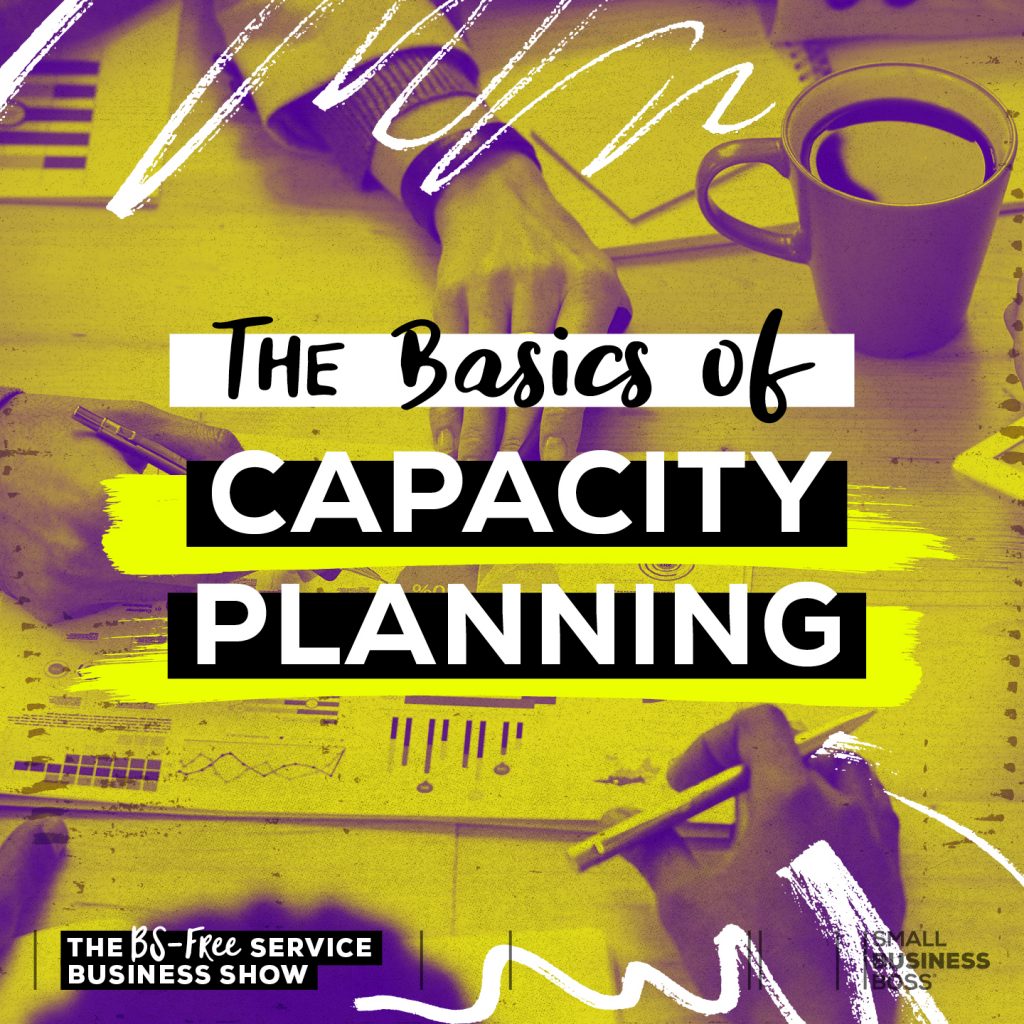
Search the site:
The Basics of Capacity Planning
We’ve all been there. Things are going great, but then we realize that we’ve bitten off more work than we can chew. We’re slammed. Overwhelmed and ready to light a match and burn down our business.
The good news is that there’s help for this, and it starts with capacity planning, where you get a better handle on the supply and demand of your business. In episode, I’m giving you a crash course on the basics of capacity planning.
In this episode, we’re diving into something I get asked about constantly by my clients, and that’s capacity planning. Whether you’re solo, or you’ve got a team, figuring out how much capacity you really have can be a massive challenge.
Honestly? Dealing with capacity as a business owner can be incredibly tricky, and it’s why I’m sometimes hesitant to talk about it.
Especially, as capacity planning is always fundamentally imperfect. No calculator or planning tool is ever going to nail it 100%. It’s a constant, never ending balance of too much vs. not enough.
This is 100% normal. There’s no magic formula or capacity meter that can fix this.
Now, before we dive in, let’s talk about what it is and why it matters.
Capacity Planning: What It Is and Why It Matters
Capacity planning is a business process to determine if you have enough resources. It’s about assessing if you have the supply to meet the demand for your services.
Even if you’re a team of one right now, capacity matters to your business, perhaps even more so than if you have a team. As a solo business owner, there’s only you and that means your time and energy is limited.
If you have a team, capacity planning helps you ensure you have enough resources to deliver on the work you’ve committed to.
For any business, it’s a way to help you manage workloads, timelines, and even what projects or clients to take on.
Sounds pretty simple, but the reality is that most of us don’t really plan in this way and we wing it. That planning can result in a host of other problems from burnout to a team with low morale to higher project costs.
In my experience, one of the biggest problems that happens on both a team and an individual level, is being unrealistic. We seriously overestimate what we can actually do in a given amount of time, and then things get seriously messy.
Creating a Plan
Getting a handle on your capacity starts with having a plan. Keep in mind that your capacity planning will be an ongoing process.
Start by looking at your supply, which includes:
- Available hours either individually or for each team member
- The time/effort required to execute tasks (aka the non-billable part of things)
- True availability. No one is 100% billable 100% of the time, it’s not possible.
- Time needed to run the business, project management, vacations, etc.
Then you want to consider if you have enough hours, and if you have any elasticity.
Once you have a handle on your supply, you need to assess the demand:
- How many client hours do you have?
- What are the non-billable hours involved?
- What is your projected demand in the next 30, 60 and 90 days?
With that information, look at if your hours are too few or too many, and if you can address any new demand. If not, you need to look at how to build capacity or delay until you can.
With all of that information, I highly recommend you look closely to see if you’re missing anything, as most capacity plans tend to be too optimistic.
Finally, if you’re finding that you’re coming up short with answers, I recommend you take two weeks and track your time in detail. Time tracking can seem tedious but until you’re working with a realistic snapshot of how time is really being spent, it’s going to be challenging to do capacity planning.
What’s Your Risk Tolerance?
Most of us only think about capacity planning when it’s too late and we’re stuck in a cycle of having too much work. We may have not enough time, or lack the right resources, and then we find ourselves trying to get out of it.
This is what’s called lag capacity planning, where you deal with it once it’s a challenge, and then you’re stuck hiring or overworking to get out of it.
On the flip side is lead capacity planning where you’re very proactive and add resources or set time aside so you’re not always running into issues.
There’s no right or wrong in how you approach it, and I find it comes down to your risk tolerance. For some of us, we’d rather wait to hire as we don’t want to take on hiring or saying no to projects when they’re coming in. On the flip side, some of us would rather not incur that risk and have open capacity that’s not being utilized to prepare for growth.
Personally, I’ve used both approaches at different times, and now I try to split the difference and add capacity in small increments when it’s needed. This is what’s called match capacity planning, and it’s been the right way for me to deal with cycles in the business.
I also aim to keep reserve capacity so that we’re not maxed out all the time. Things come up with existing clients or projects we want to work on and I don’t always want to say no or have to add resources. That reserve has come in handy many, many times in the last year.
Managing Your Capacity Plan
Once you have a loose plan, you need to start managing that plan. As you do that, you may discover that you need to constantly deal with supply issues or you have more demand than you can handle.
Here’s the good news: part of managing your capacity can be handled in a number of creative ways.
If you are constantly identifying supply issues, you may need to hire a subcontractor or a contract resource. Not every hire needs to be a permanent full-time role, and this can help you manage cyclical ups and downs.
Another way to manage supply issues is by managing client timelines more proactively, revamping deadlines or turnaround times, or enforcing client boundaries.
On the demand side, if you have too much work, it’s time to hire or crosstrain your team. If you have too few, you may need to look at your lead gen or reduce team costs.
If you’re constantly bringing in new business, use wait lists to stagger start dates and push out new business.
Finally, if you’re that in demand, it’s time to raise your prices. If you’re consistently closing 70 or even 80% of your potential clients, that’s a sign that your prices can go up. There are no bonus points for running yourself into the ground by serving everyone, when you can work with fewer clients, charge more and deliver higher quality work.
Capacity Planning is Strategic Work
I totally get that this work may seem time consuming or tedious, but it’s important. If you’re forever finding yourself frazzled and overwhelmed, capacity planning can help you pinpoint where the true issues lay, and fix them for good.
Remember, capacity planning is never going to be perfect, but it’s an essential part of running a service business, and ensuring a solid client experience. As you dive in, don’t make it more complicated than it needs to be. Even a quick look can make a significant difference.

I’m Maggie Patterson (she/her), and services businesses are my business.
I have 20+ years of experience with client services, am a consultant for agency owners, creatives, and consultants, and vocal advocate for humane business practices rooted in empathy, respect, and trust.
Read or Listen to the Latest
Check Out These Posts
Help Not Hype

Tired of the same old BS business advice?
I got you with weekly emails packed full of proven strategy that makes a real difference in your service business.









